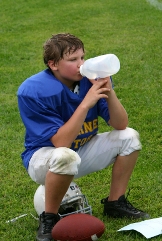In an August 24, 2015 article for the New York Times, Aaron Carroll, a professor of pediatrics at Indiana University School of Medicine, spends a lot of time debunking the myth that people need to drink eight glasses of water a day and discussing a 2015 study in the American Journal of Public Health (1) which, in reporting that more than half of children ages 6 to 19 studied were dehydrated, Carroll says, has stoked unfounded fears that "otherwise healthy ... children are walking around dehydrated, even that dehydration has reached epidemic proportions."

While recognizing that what he termed "real dehydration", such as "when the body has lots a significant amount of water because of illness, excessive exercise or sweating, or an inability to drink, is a serious issue," the problem, Carroll says, is that the study defined dehydration as a urine osmolality (a measure of urine concentration) as 800 mOsm/kg or higher, which, as a clinician, he rarely, if ever, uses to decide if a child is dehydrated, and which no study that he could find through a web search used as a measure of dehydration. Carroll claimed, citing a 1984 study (2), that the "human body is finely tuned to signal you to drink before you are actually dehydrated."
We wondered what other experts felt about the article, especially as it relates to dehydration in youth athletes, so we sent it to a longtime hydration expert, Dr. Susan Yeargin, a professor at the University of South Carolina, and our new hydration expert, Dr. Tami Hew Butler, for their reactions. Here's what they told us:
- "There is plenty of research to indicate that thirst is typically a mechanism that kicks in after someone is mildly dehydrated. The [1984] study [Carroll] referenced look[s] like a good one though. So simply, there is contraindicating evidence, which is very normal for science. However, I'd say I feel iffy about the statement in the article that thirst will happen beforehand. I'd also say we have a decent amount of research with kids indicating the two don't match up (thirst and hydration status). (Yeargin)
- There is nothing magical about 800 mOsm. However, it's the number that we work with because there hasn't been another number thrown out there. Personally, I've seen the urine samples. I think 800 is a decent number. It's a threshold number, it simply means that kids at or slightly over would be considered mildly dehydrated. The article [suggests that] people claim that anyone over the number is severely dehydrated. I don't think that is the case. So if a kid is 810 mOsm, I'd say they are mildly dehydrated, and yes, I wouldn't be terribly concerned. But 1000 or 1200, I'd definitely be concerned, based on the urine samples I've seen that are at that level. You can tell by their [urine] color that something isn't good happening [in] the kidneys because of lack of water within the body. (Yeargin)
- The only other thing is the article focused on the general population and made a point it wasn't talking about athletes. Which is good they made that point. Because athletes and child athletes are different. They are sweating a lot, peeing, breathing, etc and therefore becoming dehydrated. With athletes comes the need to themoregulate and [for peak] perform[ance]. Neither occur if someone is dehydrated. Mild to severe dehydrated is on continuum, [as] are their affects on both of those items (thermoregulation and performance). So to say dehydration isn't a concern is an understatement. It is a concern for athletes because you need those 2 things to be working right." (Yeargin)
- "It is important to note that dark urine means that the body is conserving fluids at the kidney (through stimulation of anti-diuretic hormone), by preventing water from leaving the body as urine. When the body actually needs water (to protect cell size and maintain blood flowing through the circulation) thirst is stimulated by nerves in the brain so that you actively seek fluids, drink enough to satisfy your thirst, and bring a just enough water back into the body to maintain function. There are sensors in your brain as well as in your heart which constantly monitor cell size (osmolality) and water within the circulation (plasma volume). So, you do not need external "reminders" to think about how much you need to drink, your brain is hard-wired to do so! A clear urine just signifies that you are drinking more water than the body actually needs, so the body is getting rid of this extra water. Thirst is a better guide to water intake than urine color and concentration at rest and during exercise, because thirst is directly regulated by vital organs of the body (brain and heart). Urine can be dark or concentrated from other factors like food, vitamins and even exercise". (Hew Butler)








